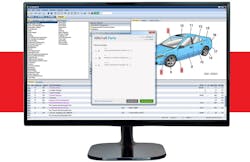In late October 2016, Mitchell International launched Mitchell Parts, a fully integrated parts procurement solution offered to all collision repair shops and their existing suppliers, in partnership with cloud-based parts procurement company uParts. The move is part of a broader focus for the company on embracing technology and delivering superior tech platforms for all segments of the collision repair industry.
Jack Rozint, Mitchell’s vice president of sales and service for its auto physical damage segment, sat down with FenderBender to discuss the numerous ways Mitchell plans to leverage new technology in 2017.
Why did Mitchell decide to go with a cloud-based platform when developing Mitchell Parts?
This is part of a much broader effort on moving all of our technology into the cloud over the next year. So, our estimating system is going to be moved to a complete cloud-based platform, and we’ve got a number of new products, some of which haven’t been announced yet, that are part of a very exciting portfolio that we’re building. Mitchell Parts is a key part of this, because, as you know, parts, depending on who you talk to, are at least 45 percent of collision repair costs. And it’s a huge part of throughput.
It’s really well designed and built and very flexible so that it gives the ability for a shop to basically design exactly how they’d like to buy parts—by DRP, by make, whether it’s an insurance-paid claim or customer-paid claim—store all that, and then the system actually helps you with every parts order automatically.
“It's that kind of ability to assist human decision making along the process.”
—Jack Rozint, VP, Sales and Service, Repair, Mitchell International
Late last year, Mitchell announced a partnership with UK-based artificial intelligence developer Tractable to do a review project that offers vehicle crash analysis based on photos. Have you heard feedback from shops on this idea? I imagine there might be some who are not all that excited about it.
We’ve received pushback, of course. Any time you are talking about photos and estimates, the immediate pushback is you cannot write an estimate from photos. And we understand that the correct way to write a complete assessment of damages after the vehicle is torn down is by an experienced damage appraiser and there’s no substitute for that. But what this technology is doing is it’s actually supplementing human decision points all along the process just to make better decisions.
For example, say all an insurer has to operate on is a cell phone picture of a car—the first notice of loss on a claim—from a tow truck driver. So wouldn’t it be nice if that car could run through a process that comes out and says, “You know what? Given all of this input about a tire that’s blown, an airbag deployed, and the analytics of the photo, there’s a high likelihood that this is going to triage as a total loss. And don’t take that car to my repair facility, where it’s going to end up sitting in the yard and I’m going to be asked to do conditioning on it, I’m not going to get any revenue on it and it’s going to take up a parking space for two weeks.” So it’s that kind of ability to assist human decision making along the process.
So you’re assisting, not replacing.
Yes. And when people say that, I say show me a fender, bring in 10 insurance appraisers, 10 independent appraisers and 10 shops and have them all tell me whether it’s a four-hour panel or an eight-hour panel. The range is going to be very broad. So what if there was a way to use 50,000 or 500,000 pictures of that same exact car’s panel that had been estimated and repaired in the last 10 years to tell you that the likelihood, based on the analytics of that damage, that one is probably going to end up being replaced.
Why was the time right for Mitchell to begin investing in this type of technology?
The thing that’s very clear right now, and I know a lot of repairers have concern about this, but the millennial generation, they like the idea of taking their cell phone out, snapping pictures, sending them to the insurance company and having that be the way their claim gets started. And that’s not going to change. If you look, there are J.D. Power studies about it and other studies about claims satisfaction. And there’s a good percentage of the population that wants to initiate their claim and self-manage their claim through their cell phone.
It’s OK not to like the idea, but it’s reality. So the question is, how can we bring that best-of-breed technology into that process to ensure that the correct decisions is made based on those cell phone apps are the best ones?
At Mitchell we’re all about one thing at the end of the day, which is getting the car repaired properly based on the right information, with the right people at the right time, supporting good decisions.
But to the people who say they don’t want anything to do with the vehicle owner taking pictures on their cell phone as part of the process, the toothpaste is already out of the tube on that one.
About the Author
FenderBender Staff Reporters
The FenderBender staff reporters have nearly four decades of combined journalism and collision repair experience.
